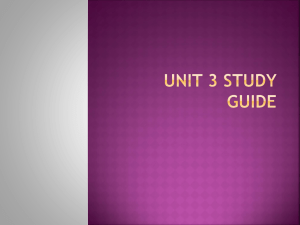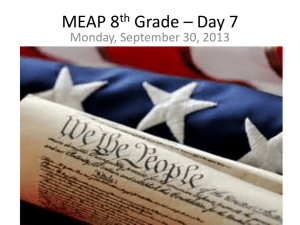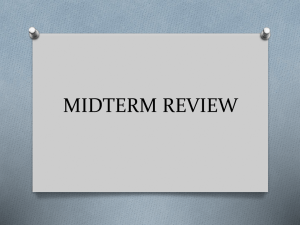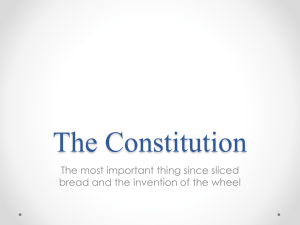DAY 17 9/5/14
advertisement
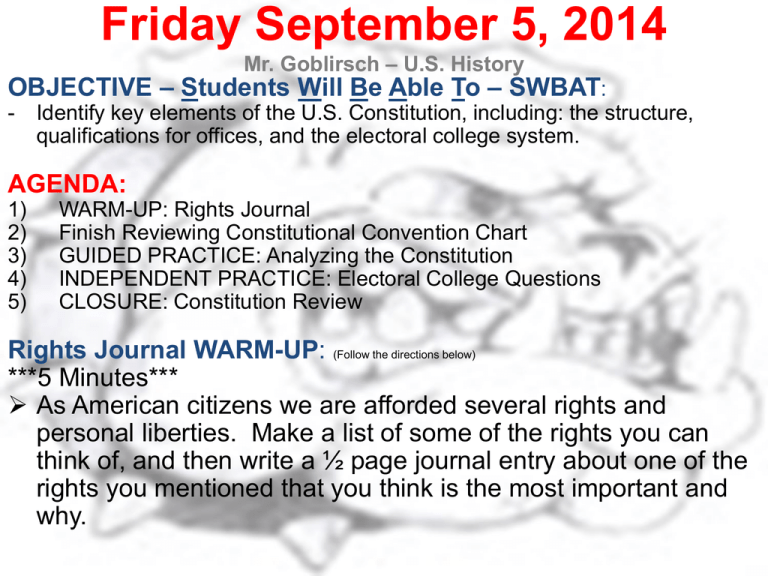
Friday September 5, 2014 Mr. Goblirsch – U.S. History OBJECTIVE – Students Will Be Able To – SWBAT: - Identify key elements of the U.S. Constitution, including: the structure, qualifications for offices, and the electoral college system. AGENDA: 1) 2) 3) 4) 5) WARM-UP: Rights Journal Finish Reviewing Constitutional Convention Chart GUIDED PRACTICE: Analyzing the Constitution INDEPENDENT PRACTICE: Electoral College Questions CLOSURE: Constitution Review Rights Journal WARM-UP: (Follow the directions below) ***5 Minutes*** As American citizens we are afforded several rights and personal liberties. Make a list of some of the rights you can think of, and then write a ½ page journal entry about one of the rights you mentioned that you think is the most important and why. Constitutional Convention (May 1787) Issues DIRECTIONS: Read Pgs. 68-71 and complete the chart below in your notebook. Briefly describe the conflict between the two sides and the compromise decided on. CONFLICT 1. Representation SIDES 1. Big v. Small States COMPROMISE 1. Briefly describe the issue 2. Slaves 2. North v. South 2. Briefly describe the issue 3. Division of Power 3. Strong Gov’t v. Strong States 3. Briefly describe the issue 4. Limiting Nat’l Gov’t authority 4. Prevent to strong of Nat’l Gov’t 4. Briefly describe the issue 5. Ratification 5. Federalists v. Antifederalists 5. CONFLICT Large States vs Small States Reps by population or Only 1 Rep COMPROMISE The Great Compromise 2 House Congress Senate (2 Reps) chosen by state legislature House of Reps (pop) chosen by voters VIRGINIA VS. NEW JERSEY PLANS Virginia Plan: Bicameral Legislature based on state population New Jersey Plan: Unicameral Legislature based on one state = one vote CONFLICT North vs South Slave Issue N Slaves not counted in pop (H of R) Slaves counted when levying taxes S Slaves counted in pop (H of R) Slaves not counted when levying taxes COMPROMISE 3/5th Compromise 3/5th of a states slaves count in population CONFLICT Strong Central Govt or Strong States Govt COMPROMISE Federalism Pwr divided between National & State govt Delegated Powers (National govt) Reserved Powers (State govt) Shared Powers (Tax & Courts) CONFLICT Limit Authority of the National Govt COMPROMISE Separation of Powers Legislative— make laws Executive— administer the laws Judicial— interpret laws & settle disputes Checks & Balances Prevents any one from dominating the others SEPARATION OF POWERS: Montesquieu CONFLICT Ratifying the New Constitution 9 out of 13 must approve it Federalists---favored balance of pwr Antifederalists--opposed strg central govt COMPROMISE Bill of Rights Govt must protect citizens & states rights and freedoms ADOPTION OF THE BILL OF RIGHTS To satisfy the StatesRights advocates, a Bill of Rights was added to the Constitution to guarantee individual rights The Bill of Rights was ratified in December of 1791- three years after the Constitution was ratified First Ten Amendments Bill of Rights 1 Freedom of speech, religion, press 2-3 Right to bear arms (citizen soldiers) No troops in private homes in peacetime 4 No searching homes without proper warrants 5-6-7-8 Fair treatment for individuals accused of crimes 9-10 Limits pwrs of fed govt 1st 10 Amendments to the Constitution Protect individual and states rights Bill of Rights First 10 Amendments to the Constitution All passed at the same time Guarantees Personal Rights & Liberties Without Bill of Rights NO RATIFICATION Amendments: 27 Total Preamble Blue Print Purpose of the Constitution The legitimacy of the Constitution comes from the American People NOT the States “We the People of the United States in order to form a more perfect Union, establish justice, insure domestic tranquility, provide for the common defense, promote general welfare, and secure the blessings of liberty to ourselves and our posterity, do ordain and establish this Constitution for the United States of America.” Article 1 Legislative Branch Congress House of Representatives & Senate Make the Law Most directly represents the people That’s why it is first Article 2 Executive Branch President Cabinet & Presidential Advisors Administer the Laws Article 3 Judiciary Branch Federal Courts & Judges Judicial Power cases involving laws & people breaking them Judicial Review Decide if Laws are Constitutional Articles 4-7 Relations between States Amending Supremacy Ratification Electoral College Questions 1. How was the electoral process for choosing the president decided on at the Constitutional Convention? 2. What do you think caused some delegates of the Constitutional Convention to be unwilling to let the people elect the president directly? 3. How is the number of electoral votes for each state determined? 4. Which six states and one district have the fewest electoral votes? How many does each have? 5. How does the electoral college “double-election” system work? 6. Explain how a presidential candidate can lose the popular vote and still become president. 7. What’s the fewest number of states a president could win and become the president? CLOSURE: Constitution Review – The Constitution is ... – The 3 branches of the U.S. government are … – The qualifications to become a Representative / Senator / President are …





